Timing drive with idler
Remove the front timing belt cover
Remove the front right wheel and engine mudguard.
Remove the alternator belt
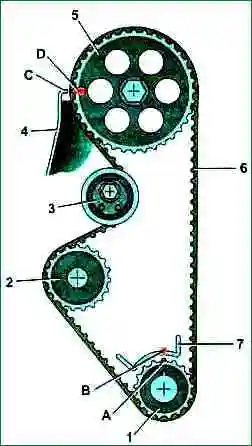
Camshaft drive diagram
Rotate the tension roller, check its condition.
Replace the roller that has play and makes a lot of noise when dyeing.
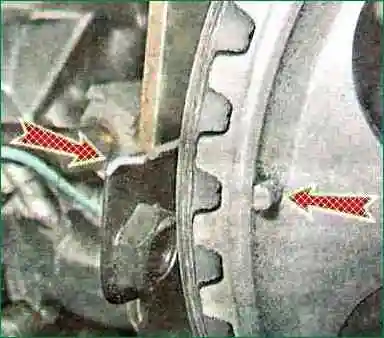
Using a 17 mm socket wrench with an extension for the pulley mounting bolt, turn the crankshaft until the mark on the camshaft pulley and the protrusion of the timing belt rear cover are aligned.
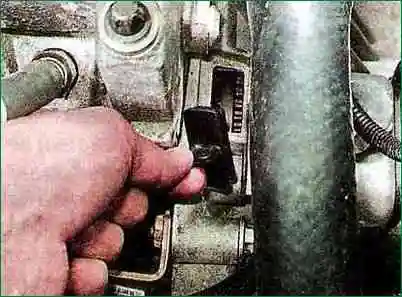
Remove the rubber plug installed at the top of the clutch housing.
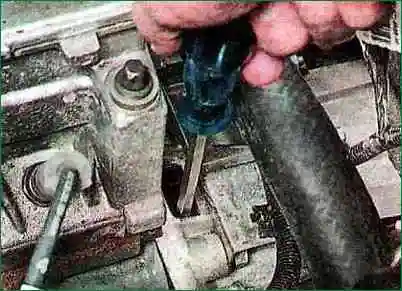
Using a 17 mm socket wrench, unscrew the bolt securing the crankshaft pulley;
At the same time, an assistant with a screwdriver inserted through the opened window between the teeth of the flywheel crown keeps the shaft from turning
Remove the pulley.
We unscrew the tension roller fastening nut and loosen the tension of the toothed belt as much as possible.
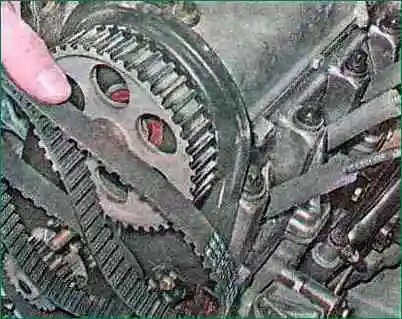
Remove the toothed belt from the pulleys.
Install
We check the coincidence of the marks on the crankshaft toothed pulley and on the tide, on the oil pump housing.
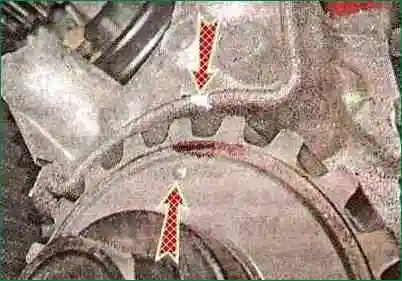
We also make sure that the mark on the camshaft pulley and the protrusion of the rear cover of the timing belt match.
We install a new belt in the following sequence, preventing the crankshaft and camshaft toothed pulleys from turning relative to the marks, we put the belt on the crankshaft toothed pulley;
slightly pulling the right branch of the belt, we put it on the camshaft pulley; we pass the belt from the inside of the tension roller and put it on the coolant pump pulley.
Adjusting the belt tension
We wrap the crankshaft pulley mounting bolt and, turning the engine crankshaft two turns, make sure that the marks on the pulleys and the engine match. If necessary, reinstall the belt.
We install the crankshaft pulley in place and tighten the bolt of its fastening to a torque of 97.9-108.8 Nm (9.9-11.1 kgf / m)
Reinstall the front timing belt cover, alternator belt and parts that were sacred during disassembly.
Timing drive with automatic tensioner
Preparing the car for work.
Remove the upper front timing belt cover.
If you remove the timing belt not for replacement, mark the direction of its rotation with a marker. When building, it should be set according to the label.
Remove the front right wheel and place the car on a secure stand.
Remove the right side of the engine mudguard.
Remove the alternator drive belt.
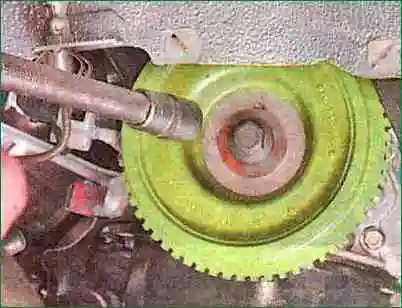
Using a 17 mm socket wrench, turn the crankshaft until the marks on the camshaft pulley align with the mark on the rear timing belt cover.
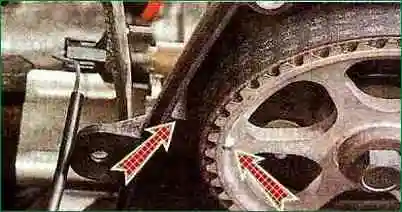
This position will correspond to the position of the crankshaft at TDC on the compression stroke of the first cylinder.
It is not allowed to rotate the crankshaft using the camshaft pulley bolt.
In the following operation, the crankshaft can be held by a slotted screwdriver on the flywheel ring gear by removing the rubber plug installed on top of the clutch housing.
Also, the crankshaft pulley bolt can be loosened if an assistant shifts into high gear and depresses the brake pedal.
This may cause the crankshaft to rotate slightly. Therefore, you need to double-check that all labels match.
Using a 17 mm socket wrench with an extension, unscrew the bolt securing the crankshaft pulley and remove the pulley.
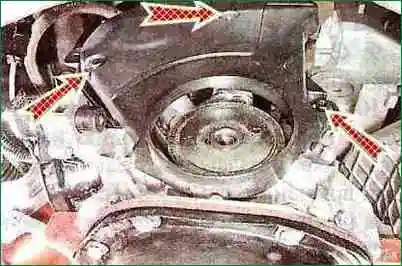
Using a 5 mm hexagon wrench, unscrew the three bolts securing the lower front cover of the timing belt.
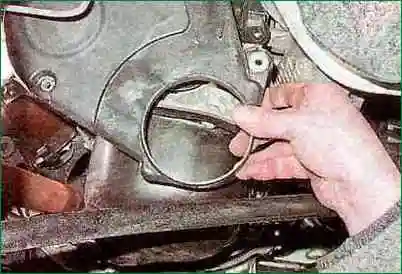
Remove the cover.
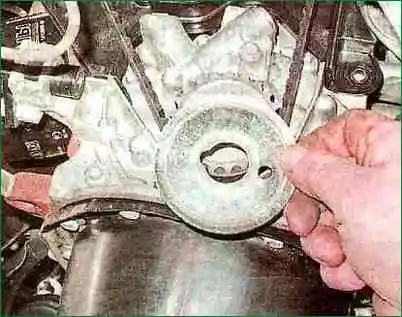
Remove the limit washer from the crankshaft.
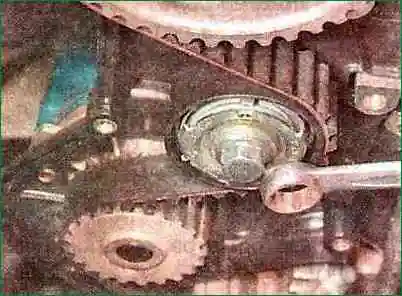
Using a 15 mm wrench, turning the automatic tensioner mounting bolt half a turn counterclockwise, loosen the timing belt tension.
Remove the timing belt.
After removing the belt, check the condition of the tensioner.
Installing the timing belt
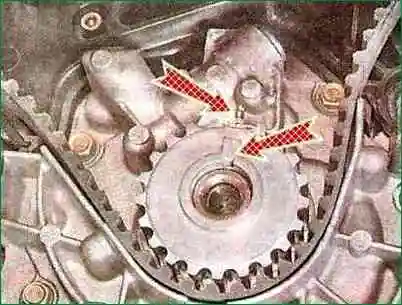
We put on a new belt, laying its branches in accordance with the figure, and making sure that the mark on the crankshaft toothed pulley is located opposite the tide made on the oil pump housing
We put the belt on the camshaft pulley so that the front branch is stretched.
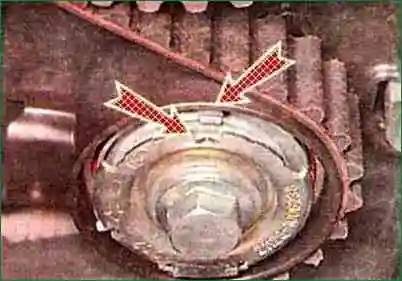
Without letting the belt loosen, we put it on the pump pulley and on the tensioner pulley
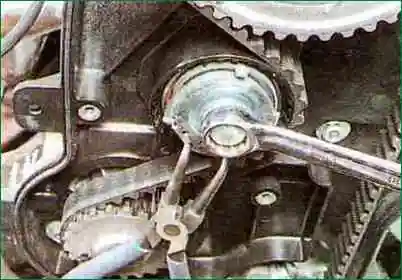
With a puller for retaining rings, turn the tensioner in the direction of the arrows until the marks on it align and with a 15 mm wrench, tighten the bolt of its fastening to a torque of 33.2-41.2 Nm (3.4 - 4.2 kgf / m).
If at the same time the camshaft has turned, then loosen the belt and reinstall it by turning the incorrectly installed camshaft (permissible mismatch of marks within one tooth of the camshaft pulley).
By turning the crankshaft two turns (by the flywheel ring or by wrapping the pulley mounting bolt into the shaft), we make sure that the relative position of the shafts is not violated by the coincidence of the marks.
If necessary, aligning the marks, repeat the installation of the belt.
After combining all the marks, we install the parts removed from the car in place.





